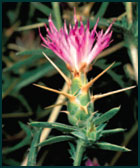
In the literature of environmental groups, the alert has a familiar doomsday ring: “An invasion is under way that is undermining our economy and endangering our most precious natural treasures,” says NatureServe (2003), a network of natural heritage programs that monitors endangered species. Among the groups that have made invasives a top priority are the Nature Conservancy, Defenders of Wildlife, the Union of Concerned Scientists, World Resources Institute, Conservation International, the Wilderness Society, Environmental Defense, Natural Resources Defense Council, the Sierra Club, and the National Audubon Society.
Farms, forests, highway departments, parks, and homeowners have been fighting invasive species for over a century. Agricultural stores and the garden section of every department store offer remedies to attack invasive species ranging from herbicides to traps and bullets. Individual species such as chestnut blight, kudzu, and the zebra mussel have made national news from time to time. In the past year, however, government agencies have joined environmentalists in an increasingly popular war against invasives in general. Why has this old, ever-simmering guerilla war suddenly become a first-magnitude environmental issue?
First, nothing unites a country like an invasion, and the war against invasive species has created rare common ground between the Bush administration and its sworn foes.
Second, the problem is real, it is big, and it is both an economic and an environmental issue. Since the advent of European settlement in North America, over 50,000 species of plants alone have been introduced. While many enhance our landscaping and others provide 98 percent of our crops, some 5,000 have gone wild to compete with 17,000 or so native plants (Morse, Kartesz, and Kutner 1995; Morin 1995). Estimates of how fast and how extensively they are replacing natives vary, but no one who has seen the blooms of garlic mustard in eastern forests, the broad yellow fields of starthistle in the West, swarms of starlings in the suburbs, or the hair-thick stands of melaleuca in the Everglades can doubt that change is everywhere.
Australian melaleuca grows much more densely in the Everglades than in its native habitat and is spreading at a rate of 29,700 acres a year (Campbell 1994). It has real costs to both wildlife and to the free-flowing water regime that filters and provides much of Florida’s water. In Utah’s Great Basin, European cheatgrass has accelerated fire frequency from every 60 to 110 years to every 3 to 5 years, and cheatgrass has come to dominate some 5 million acres in Idaho and Utah (Whisenant 1990).
Animal invaders are not as numerous, but in many cases they cause greater and more immediate damage, especially insects and mites. Farmers may lose $13 billion in crops to introduced insects every year (Pimentel et al. 1999). About 100 introduced insects have become serious forest pests, accounting for some $2 billion in annual losses. To these obvious costs we should add the burdens on homeowners, fisheries, and human health, as well as the expenditures to control the invasives.
Other factors, too, lie behind this new war on invasives. For environmental pessimists, the damage done is one more proof that humankind has ruined nature and should not disturb nature’s landscape plan. Emotional exaggeration and junk science are brought to the aid of this message and the cause of preservation: “An estimated 7 million acres are currently infested with invasive species on our national forests,” claims the National Forest Protection Alliance (2003). “At the current rate of spread, the entire national forest system will be covered with invasive species by 2035.” This is a restatement of the “population bomb” argument that projects a given trend to infinity. Environmental misanthropes seem to think that this time the statistical nonsense might work because the problem and its costs are visible everywhere.
The invasive species issue also has a convenient link to one of the great bugaboos of liberal activists–globalization. Increased global trade has indeed sped up the movement of biological agents between countries, radically accelerating its ancient role in the spread of invasive species. Some environmentalists have already proposed controversial constrictions on international trade. Forestry activist and respected plant ecologist Jerry Franklin has declared, “It’s time to stop moving green plants and raw wood between continents” (quoted in McClure 2003).
While the problem is large and even frightening (consider the arrival of the West Nile virus), the negatives are not the whole story. The invasive species issue shares the lopsided treatment given global warming. A complete balance sheet would note that many introduced species, including invasives, have had economic and social benefits. In fact, many species, like kudzu (used for erosion control in the Southeast), were introduced for their benefits and have provided those benefits even as escapees. Many invasives are only unwelcome when they are in superabundance or in the wrong place.
The zebra mussel, notorious for clogging power plant intakes, also filters and clarifies water, benefiting plant and fish populations. Tamarisk, or salt cedar trees, were introduced in the early 1800s for their ability to grow rapidly (up to 12 feet a year), provide dense windbreaks, and colonize heavily saline soils where little else will grow. It turns out salt cedar invasions have been a boon to populations of the endangered willow flycatcher, which prefers salt cedars for nesting (Barranco 2001). If Louisiana’s efforts to create a market for the large muskrat-like nutria that destroys wetlands succeed, the market could turn a negative into a positive. Judgments about some invasives, such as salmon in the Great Lakes, are a matter of environmental preference, and the European honey bee, a continuing boon to farms and gardens across America, appears to have no organized opposition.
While farmers are well aware of the costs of invasives, they are also frightened by the potential for eco-pessimists to capture the issue. The “green plants” that Jerry Frankin wants to keep home could come to mean green vegetables and live animals. Michele Dias, a California Farm Bureau Federation attorney, says, “Unless farmers and ranchers become active in their approach to this issue now, due to heavy environmental influence, federal controls could far surpass the type of abuses of power already experienced with the Endangered Species Act” (Dias 2003). Activists have already convinced a judge in Maine to order salmon pens emptied, on the grounds that escaping hatchery salmon are invasives.
Yes, the invasive species issue is a real problem–more easily documented and already more damaging economically and environmentally than global warming. Environmental pessimists can take a major part of the credit for bringing the issue onto the public stage. Yet to see the invasive species issue as a choice between the native environment and alien species, between preservation and human meddling, between market choices and government controls, obscures the real issue. All species in America were introduced at some time, and all “native” dominants from Ponderosa pine to the American bison and bald eagle were once successful invasives. The heart of the matter is not figuring out how to restore some “native” ecosystem. After all, which native system would we restore? Pre-Columbian, pre-Indian, Ice Age, or pre-Ice Age? The choice is arbitrary.
We can never stop this problem, but we can learn to live with it if we commit ourselves to flexible informed management rather than to panic regulation and symbolic action. We will make intelligent decisions only when the debate shifts from the unsupportable notion that “native” is always better to the all-important question of how we manage change in our natural economy. Having identified and agreed on a real problem, we now must put the most effective tools in the hands of those who are most capable of tackling it.
No problem ever defied centralized solutions more than invasive species in all their diversity of character, attacks, and local severity. The most effective managers are usually those who have an economic interest in the results. Thus, farmers, ranchers, forest owners and homeowners must have ready access to the best intelligence (that is, science) and the necessary defensive weapons. These may range from hunting rights for mute swans to using pesticides against garlic mustard and starthistle. Just when biotechnology is giving us powerful and diverse defensive measures unimagined just a decade ago, we would make a serious mistake to take a “one-regulation-fits-all” approach.
REFERENCES
Barranco, Angela. 2001. Invasive Species Summary Project: Saltcedar (Tamarix ramosissima). November 11. Columbia University. Online:www.columbia.edu/itc/cerc/danoff-burg/invasion_bio/inv_spp_summ/Tamarix_ramosissima.html (cited Nov. 11, 2003).
Bosworth, Dale. 2003. We Need a New National Debate. Presentation at the Izaak Walton League Annual Convention, Pierre, SD, July 17.
Campbell, F. T. 1994. Killer Pigs, Vines, and Fungi: Alien Species Threaten Native Ecosystems. Endangered Species Technical Bulletin 19(5): 3-5.
Dias, Michele. 2003. Farmers Must Be Involved in Invasive Species Debate. August 6. California Farm Bureau Federation. Online: www.cfbf.com/agalert/2003/08_06_03_op-ed.aspx (cited Nov. 11, 2003).
McClure, Robert. 2003. Debate over Forests is a Difference in Priorities. Seattle Post Intelligencer, October 14. Online:seattlepi.nwsource.com/local/143796_rey14.html (cited November 12, 2003).
Morin, N. 1995. Vascular Plants of the United States. In Our Living Resources: A Report to the Nation on the Distribution, Abundance, and Health of U.S. Plants, Animals and Ecosystems, ed. E. T. Laroe, G. S. Farris, C. E. Puckett, P. D. Doran, M. J. Mac. Washington, DC: U.S. Department of the Interior, National Biological Service, 200-205.
Morse, L. E., J. T. Kartesz, L. S. Kutner. 1995. Native Vascular Plants. In Our Living Resources: A Report to the Nation on the Distribution, Abundance, and Health of U.S. Plants, Animals and Ecosystems, ed. E. T. Laroe, G. S. Farris, C. E. Puckett, P. D. Doran, M. J. Mac. Washington, DC: U.S. Department of the Interior, National Biological Service,.
National Forest Protection Alliance. 2003. 205-209The National Forest Protection and Restoration Act: Restoring Our National Forest and Revitalizing Rural Communities. Sept. 21. Online: www.forestadvocate.org/news/RESTOR.FS.WEB.pdf (cited November 11, 2003).
NatureServe. 2003. Conservation Issues: Invasive Species. Online: www.natureserve.org/conservation/invasivespecies.jsp (cited October 23, 2003).
Pimentel, David, Lori Lach, Rodolfo Zuniga, and Doug Morrison. 1999. Environmental and Economic Costs Associated with Non-Indigenous Species in the United States. College of Agriculture and Life Sciences, Cornell University, Ithaca, NY, June 12.
Whisenant, S. G. 1990. Changing Fire Frequencies on Idaho’s Snake River Plain: Ecological and Management Implications. In Proceedings-Symposium on Cheatgrass Invasion, Shrub Die Off, and Other Aspects of Shrub Biology and Management, comp. E. D. McArthur, E. M. Romney, S. D. Smith, and P. T. Tueller. USDA Forest Service General Technical Report INT-276. Ogden, UT: Intermountain Research Station, 4-10.
Wallace Kaufman is the author of Coming Out of the Woods (Perseus Publishing) and No Turning Back (iUniverse.com) and is a previous contributor to PERC Reports.



